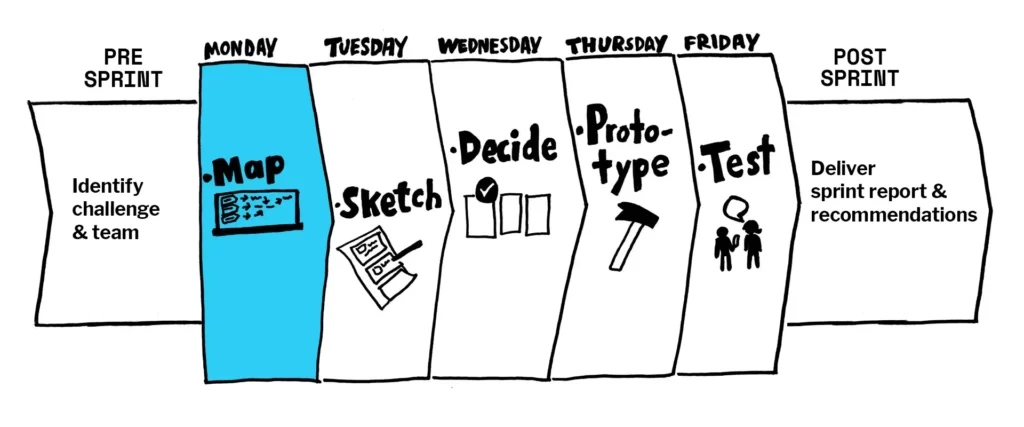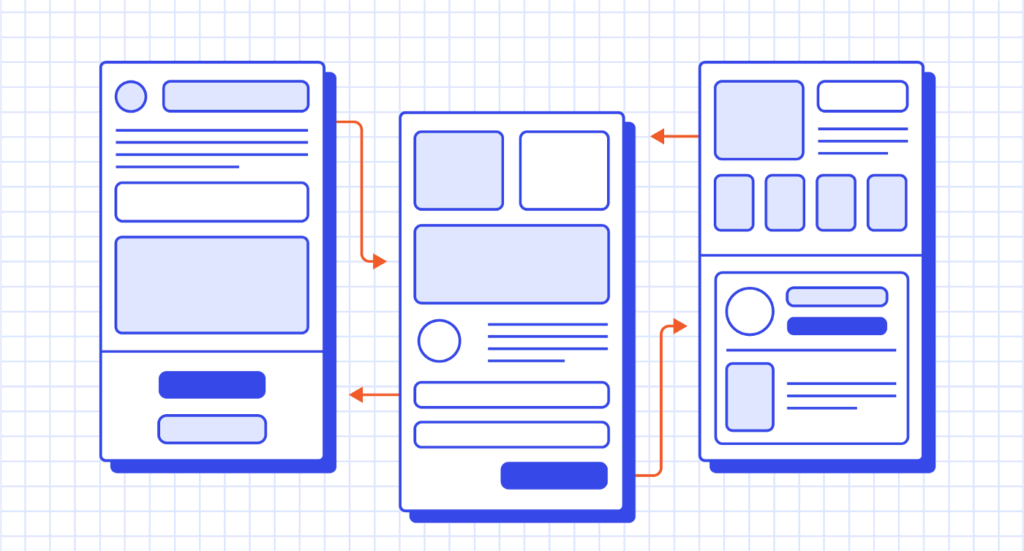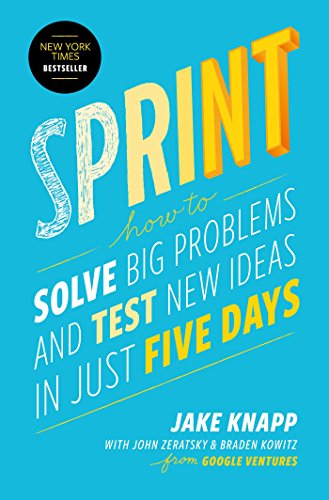How a Design Sprint Can Unlock Innovation
If you've ever found yourself stuck in a creative rut, longing for a burst of fresh ideas, then you're in for a treat. Today, we're diving headfirst into the world of design sprints and exploring how this robust methodology can unlock innovation like never before.
In a world where innovation is the lifeblood of success, companies of all sizes constantly seek new ways to stay ahead of the curve. However, the traditional approach to innovation often involves long and arduous processes, making it challenging to bring ideas to life quickly. This is where design sprints come into play, revolutionising how teams collaborate and innovate.
Now, let's get down to why design sprints are a game-changer. According to a recent survey by McKinsey, companies that prioritise innovation achieve 50% higher revenue growth than their counterparts. Furthermore, a Design Management Institute (DMI) study revealed that design-driven companies outperformed the S&P 500 index by a staggering 219% over a decade.
Design sprints catalyse innovation by fostering a culture of experimentation, collaboration, and rapid learning. By compressing the time frame, these sprints allow teams to bypass the endless cycles of meetings, analysis paralysis, and decision bottlenecks that often plague traditional approaches. Instead, they propel teams forward, driving them to quickly test and iterate on ideas, fail fast, and ultimately arrive at breakthrough solutions.
Imagine the power of a process that empowers you to uncover user insights, identify pain points, generate many ideas, and validate them—all within days. Design sprints are precisely designed to do just that, eliminating the guesswork and enabling you to make data-driven decisions with confidence.
In the upcoming blog posts, we'll delve deeper into the various stages of a design sprint, exploring how each phase contributes to the overall journey towards innovation. From defining the problem to prototyping and testing solutions, we'll provide practical insights, tips, and tricks to help you master the art of design sprints.
So, buckle up and prepare to embark on an exhilarating adventure that transforms your approach to innovation. Together, we'll unleash the full potential of design sprints and ignite the spark of creativity that lies within. Stay tuned for our next blog post, where we'll dive into the first stage: “Understanding the Problem: Framing the Challenge for Success.”
Remember, innovation knows no bounds, and with design sprints, you'll soar to new heights quickly. Let's revolutionise the way we innovate together!
Table of Contents
What is a Design Sprint?

Definition and Origins
Have you ever wondered how teams develop fantastic product or service concepts in such a short time? Well, that's where a design sprint comes in! It's a structured and time-boxed process that guides teams through the exciting journey of ideation, prototyping, and testing.
You might be interested to know that the concept of a design sprint was popularised by none other than Google Ventures (GV), the venture capital arm of Google. They even wrote a fantastic book called “Sprint: How to Solve Big Problems and Test New Ideas in Just Five Days” to share their insights. The book, authored by Jake Knapp, John Zeratsky, and Braden Kowitz, has become a go-to resource for teams looking to supercharge their innovation process.
- Hardcover Book
- Knapp, Jake (Author)
- English (Publication Language)
- 288 Pages – 03/08/2016 (Publication Date) – Simon & Schuster (Publisher)
Drawing inspiration from design thinking principles and agile methodologies, a design sprint aims to condense months of work into a concentrated and action-packed period, typically spanning just five days. It's all about embracing efficiency and collaboration to accelerate the journey from concept to tangible prototype.
During a design sprint, teams work together closely, leveraging their collective expertise and diverse perspectives. They start by identifying the problem they want to solve or the idea they want to explore. Then, armed with brainstorming techniques and various creative exercises, they generate many ideas. It's like a bubbling cauldron of creativity!
Once the ideas flow, the team narrows their options, carefully selecting the most promising concepts. These chosen ideas are transformed into quick and tangible prototypes. Don't be mistaken—these prototypes aren't polished final products. Instead, they visually represent the idea, allowing the team to gather valuable feedback and insights.
But the journey doesn't stop there! The team takes their prototypes and tests them with real users. By observing how people interact with the prototypes, they can uncover critical insights about usability, desirability, and overall effectiveness. This user feedback is precious and can drive further iterations and improvements.
In a nutshell, a design sprint is like a power-packed innovation boot camp. It combines design thinking and agile methodologies to help teams leapfrog traditional, time-consuming processes. By compressing months of work into five days, units can swiftly transform their ideas into tangible prototypes and validate them with real users. It's an exhilarating and collaborative adventure that sparks creativity, drives innovation, and delivers remarkable results.
Objectives of a Design Sprint

Design sprints are all about solving essential business questions and making well-informed decisions for product development. They're like intense brainstorming sessions on steroids, where teams rapidly iterate and validate ideas with users. The beauty of design sprints lies in their ability to bring together a diverse group of experts from different disciplines. Design sprints encourage collaboration and create an environment where many perspectives can be explored by uniting minds from various backgrounds. This ensures that the team comprehensively understands the problem they're trying to solve.
But design sprints aren't just about problem-solving but also catalysts for creativity. When you gather a bunch of passionate individuals in a room and give them the freedom to think outside the box, magic can happen. Design sprints provide a structured framework that nurtures innovation, pushing participants to push their boundaries and develop unique solutions. This creative energy fuels the sprint and inspires team members to think differently in their day-to-day work.
Another remarkable aspect of design sprints is their ability to boost team morale. When teams are actively involved in the decision-making process and witness their ideas taking shape, it instils a sense of ownership and pride. Design sprints create a safe space for individuals to contribute their expertise and feel valued, fostering a positive team dynamic. The collaborative nature of the sprint also encourages bonding and trust-building among team members, leading to stronger relationships that extend beyond the sprint itself.
Moreover, design sprints are a powerful tool for creating a shared vision. By immersing everyone involved in the process, from designers to developers to stakeholders, a unified understanding of the end goal is established. This shared vision ensures that all team members are aligned and moving in the same direction, reducing friction and enhancing overall productivity. It becomes a rallying point that guides decision-making and acts as a compass when challenges arise.
Critical Benefits of Design Sprints
Design sprints offer several benefits that make them a compelling approach to innovation:
- Speed and Efficiency: Design sprints are time-boxed, typically lasting only five days, allowing teams to accelerate product development. By compressing work into a short timeframe, companies can quickly validate assumptions and make informed decisions about the viability of an idea.
- Collaboration and Alignment: Design sprints bring together cross-functional teams, including designers, developers, marketers, and stakeholders, fostering cooperation and alignment. This multidisciplinary approach ensures that different perspectives and expertise are considered, leading to a more comprehensive and well-rounded solution.
- User-Centric Approach: Design sprints place a strong emphasis on understanding the needs and behaviours of users. By incorporating user research and testing early in the process, design sprints help teams gain valuable insights and validate assumptions, resulting in user-centred products that resonate with their target audience.
- Reduced Risk and Cost: Through rapid prototyping and user testing, design sprints minimise the risk of investing time and resources into an idea that may not work. By identifying potential flaws and refining concepts early on, companies can avoid costly mistakes and pivot if necessary, saving time and money in the long run.
The Design Sprint Process

A design sprint typically consists of five distinct phases, each with specific objectives and activities. Let's dive into each step to understand better how a design sprint unfolds.
Phase 1: Understand
The first phase of a design sprint is dedicated to understanding the problem space and defining the challenge at hand. During this phase, the team researches gathers insights, and identifies user needs and pain points. The primary activities in this phase include:
- Stakeholder Interviews: Engaging with stakeholders to gather their perspectives, expectations, and requirements.
- User Research: Conducting interviews, surveys, or observations to gain a deep understanding of the target users' needs, behaviours, and pain points.
- Competitive Analysis: Analysing competitors' products or services to identify gaps and opportunities.
- Problem Framing: Defining a clear problem statement as a guiding light throughout the design sprint.
By the end of the Understand phase, the team should have a solid understanding of the problem space and a clear problem statement to address in the subsequent steps.
Phase 2: Diverge
The team aims to generate ideas and potential solutions in the Diverge phase. This phase encourages divergent thinking and creative exploration. Key activities in this phase include:
- Brainstorming: Facilitating brainstorming sessions where team members generate ideas individually or collaboratively.
- Crazy 8s: Allowing team members to sketch multiple quick ideas in eight minutes, fostering rapid idea generation.
- Mind Mapping: Creating visual diagrams to explore relationships between ideas and uncover new possibilities.
The Diverge phase promotes a non-judgmental environment where wild ideas are encouraged, enabling the team to explore innovative solutions and push boundaries.
Phase 3: Decide
After generating many ideas, the team enters the Decide phase, evaluating and selecting the most promising concepts. The key activities in this phase include:
- Voting: Each team member votes on their favourite ideas, highlighting the ones they believe have the most potential.
- Heat Map: Visualising the voting results to identify the ideas with the highest consensus and most significant collective interest.
- Concept Selection: Collaboratively discussing and selecting the ideas to prototype and test in the next phase.
The Decide phase enables the team to converge on critical ideas, ensuring that the most valuable concepts are prioritised for prototyping and testing.
Phase 4: Prototype

In the Prototype phase, the team brings the selected ideas to life through rapid prototyping. The primary goal is to create tangible representations of the concepts that can be tested with users. The activities in this phase include:
- Sketching: Translating the selected ideas into rough sketches or wireframes that capture critical functionality and interactions.
- Storyboarding: Creating a narrative that illustrates the user's journey and showcases how the prototype addresses their needs.
- Digital or Physical Prototyping: Developing interactive prototypes using digital tools or building low-fidelity physical prototypes.
By the end of the Prototype phase, the team should have a set of realistic prototypes ready for user testing in the next stage.
Phase 5: Validate
The final phase of a design sprint is dedicated to validating the prototypes with real users. During this phase, the team collects feedback, iterates on the prototypes, and gathers insights to inform future iterations. The key activities in this phase include:
- User Testing: Conducting usability tests with target users, observing their interactions and collecting feedback.
- Iterative Refinement: Incorporating user feedback and making iterative improvements to the prototypes.
- Learning Review: Reflecting on the outcomes of the design sprint, capturing key learnings, and identifying next steps.
The Validate phase provides valuable user insights that inform the next steps in the product development process, helping the team refine and enhance their ideas based on real-world feedback.
Industries Leveraging Design Sprints
Design sprints have gained traction across various industries, proving to be a valuable approach for innovation and problem-solving. Let's explore some sectors that have embraced design sprints:
Technology and Software Development
The technology sector has been at the forefront of adopting design sprints. Companies in this industry understand the importance of rapidly iterating and delivering user-centric products. Design sprints help technology and software development teams validate assumptions, reduce time-to-market, and foster collaboration across disciplines.
E-commerce and Retail
The e-commerce and retail industries are highly competitive, with customer experience crucial to their success. Design sprints enable companies in these industries to test new features, improve user interfaces, and optimise the shopping experience. By quickly iterating and testing ideas, e-commerce and retail businesses can stay ahead of the competition and provide customers with seamless and enjoyable interactions.
Healthcare and Medical Innovation
Design sprints have been leveraged in healthcare to drive innovation and improve patient care. Design sprints help healthcare organisations identify and address pain points in their services, develop user-friendly medical devices, and streamline workflows. By involving patients, healthcare professionals, and technology experts in the design sprint process, new solutions can be created to enhance healthcare outcomes.
Financial Services
Design sprints have also found their way into the financial services industry. Banks, insurance companies, and fintech startups use design sprints to reimagine their digital products, improve user experiences, and develop innovative financial solutions. The collaborative nature of design sprints allows teams to align on customer needs, identify opportunities for disruption, and create financial products that are intuitive and customer-centric.
Product Design and Manufacturing
Design sprints have long been utilised in the product design and manufacturing industries. From consumer goods to industrial equipment, design sprints help companies develop and iterate on product concepts, optimise manufacturing processes, and ensure that products meet user needs and expectations. By involving designers, engineers, and manufacturing experts in the design sprint process, companies can streamline product development cycles and bring high-quality products to market faster.
The Impact of Design Sprints
Design sprints are a robust methodology for fostering innovation and driving business success. Let's explore some of the notable impacts of design sprints:
Accelerated Time-to-Market
One of the most significant advantages of design sprints is their ability to compress the product development timeline. By focusing on rapid prototyping and user testing, design sprints help companies bring ideas to market faster. This accelerated time-to-market allows businesses to gain a competitive edge, seize new opportunities, and adapt to rapidly changing market conditions.
Increased Customer Satisfaction
Design sprints prioritise understanding user needs and incorporating user feedback throughout the process. Companies can develop products that align with customer expectations by involving users in the design and validation stages. This customer-centric approach leads to higher customer satisfaction and loyalty, as products are designed with the user's experience in mind.
Risk Mitigation
Design sprints help mitigate risks associated with product development by validating assumptions and uncovering potential flaws early in the process. By prototyping and testing ideas with users, companies can identify and address usability issues, market fit problems, or technical challenges before making significant investments. This risk mitigation approach saves resources and reduces the likelihood of product failure.
Enhanced Collaboration and Communication
The collaborative nature of design sprints fosters cross-functional teamwork and breaks down silos within organisations. Design sprints encourage collaboration, knowledge sharing, and collective decision-making by bringing together individuals from different disciplines and perspectives. This collaborative environment improves communication, strengthens relationships, and enhances team dynamics.
Conclusion
Design sprints have revolutionised the way companies approach innovation and product development. Design sprints enable teams to rapidly prototype, validate, and iterate on ideas by condensing the process into a time-constrained and collaborative framework. The benefits of design sprints, such as speed, collaboration, user-centricity, and risk reduction, have made them a popular approach across industries. From technology and e-commerce to healthcare and manufacturing, organisations leverage design sprints to unlock innovation, deliver better products, and stay ahead in today's competitive landscape. Embracing design sprints allows companies to harness the power of creativity, collaboration, and customer-centricity, ultimately driving business success in an ever-evolving marketplace.
Last update on 2024-06-07 / Affiliate links / Images from Amazon Product Advertising API

